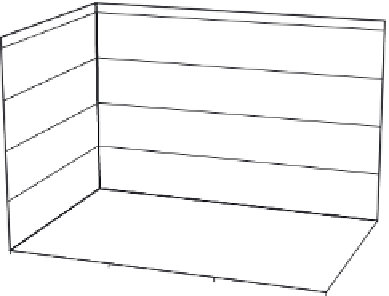Biomedical Engineering Reference
In-Depth Information
200
150
100
50
Enamel
0
Dentin
Esthet-X
Grandio
Supreme XT
FIGURE 4.7
Graphic representation of compressive strength (MPa) of
nanofilled composites in dentin and enamel shades.
Source: Balbinot and Mota (2006).
up to 800 N. The relation between the maximum strength (N) applied on a sample divided by the
sectional area (mm
2
) results in the maximum compressive strength in megapascal (MPa). A compara-
tive view in
Figure 4.7
describes the compressive strength of nanofilled composites. The compressive
strength ranges from 146.63 to 206.08 MPa. There was no statistical difference between them and in
both shades (Anova and Tukey,
P
0.18).
4.8.2
Diametral Tensile Strength
This
in vitro
methodology was developed to test the cohesion of materials when subjected to tensile
stress. However, when brittle materials are exposed to tensile stress, they are most likely to break eas-
ily. The diametral tensile test applies a compressive load into a cylindrical-shaped sample, resulting in
elongation as an indirect tensile strength. This mechanical property is calculated (MPa) as a relation of
two times the maximum strength recorded under the relation of
π
, diameter and height of the sample.
The diametral tensile strength (MPa) ranged from 34.87 to 50.26 (
Figure 4.8
). There was a significant
difference between the composites (
P
0.02). Supreme XT enamel shade was statistically higher than
Esthet-X Dentin. The other composites and shades did not differ from both resins studied
[21]
.
Besides the results after 24 h of storage, the effect of artificial accelerated aging on mechani-
cal properties has also been recorded
[22]
. Samples of nanofilled composites were submitted up to
300,000 mechanical cycles of 80 N at 37°C.
Figure 4.9
presents the effect of this load on nanofilled
composites. The results (MPa) ranged from 41.6 (Esthet-X) to 53.39 (Supreme XT). No differences
were recorded between composites submitted up to 300,000 mechanical cycles and the samples
which were not submitted to the mechanical loading cycle. This means that nanofilled composites
might support the masticatory load better than other microhybrid composites.












